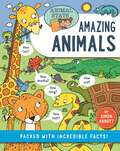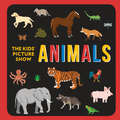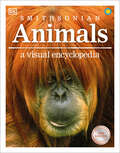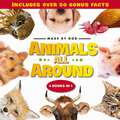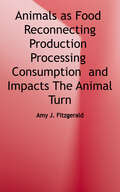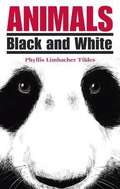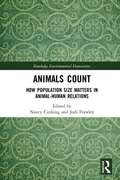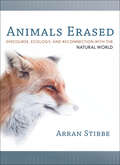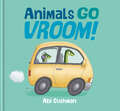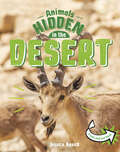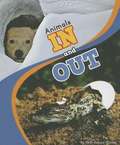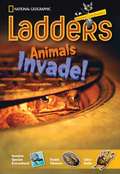- Table View
- List View
Animals (Animal Stats)
by Simon AbbottDo you think you're an animal expert? Get the stats on the BIGGEST, the smallest, the fastest, the LOUDEST and much more!Packed with fascinating facts, stats and data, curious kids will be amazed to learn about the millions of animal species that share our planet, as well as habitats, animal adaptations and how to help our planet's biodiversity. Simon Abbott's fun characters draw in curious minds by answering the science and numeracy questions kids want to know, with the super-impressive answers found in nature!The Animal Stats series features accessible text paired with bright, colourful artwork, ideal for readers aged 6+, and includes a creature quiz at the back of the book to test their knowledge. Other titles in the series include Minibeasts, Sea Life and Dinosaurs.
Animals (Britannica Discovery Library, #5)
by Encyclopaedia BritannicaIntroduces children to animals.
Animals (Glenco Science-Unit #3)
by Mcgraw Hill Education"This Glenco Science Unit 3 Animals textbook contains chapters on Animal Diversity, Animal Structure and Function, Animal Behavior and Reproduction.
Animals (The Kids' Picture Show)
by Chieri DeGregorio Steve DeGregorioGet ready for an animal adventure with your little explorer! The Kids' Picture Show books, inspired by the hugely popular YouTube channel, introduce young readers to first words in cool 8-bit style.This sturdy board book, packed with images of animals, is the perfect introduction to creatures from around the world for babies and toddlers. The 8-bit illustration style makes the book even more fun and accessible for young children, and will also appeal to parents, grandparents, and everyone who has played classic video arcade games.
Animals A Visual Encyclopedia
by DKSee the animal kingdom up close and personal in this ultimate reference book for children.Filled with more than 700 photographs, habitat maps, and illustrations, Animals A Children's Encyclopedia helps children and parents learn about the rich variety of animal life on our planet.Meet the deadliest, largest, friendliest, fastest and downright strangest animals known to man, and discover what they look like, where they live, what they do, what they eat and what life is like for their young. From the latest research to recent numbers on populations, this book gives you all the information you need about animals on land, in water, and in the air.This animal encyclopedia for children offers:- An introduction to the animal kingdom through photographs of hundreds of animals accompanied by informative text.- A new and updated edition of a popular title in the Children&’s Encyclopedia series, which has sold millions of copies worldwide.- A global scope of information, covering all key habitats and continents from around the world.At a time in history when climate change and habitat loss are profoundly affecting animals, this book helps educate children about all the creatures in the world that are at risk of vanishing forever.From the same series as the New Children's Encyclopedia and DK children's encyclopedias of Science, Art, and Geography (among others), this updated animal encyclopedia is full of valuable reference information for children, parents, and educators. Learn all about the world one subject at a time!If you like Animals A Children&’s Encyclopedia then why not complete the collection? Part of popular New Children&’s Encyclopedia series, avid readers can enjoy Legends and Sacred Stories, Art, Myths, and Ocean A Children&’s Encyclopedia.
Animals All Around (Made By God)
by ZondervanAnimals All Around is a nonfiction Level 2 I Can Read Made By God bind up. With photos and facts showing children the wonders of God’s creation, this collection includes four complete I Can Read titles with the addition of bonus fun and amazing facts about the creation they feature. All facts align with the Common Core Standards for informational reading for young readers. Animals All Around Us Forest Friends Our Feathered Friends Cats, Dogs, Hamsters, and Horses Barnyard Critters
Animals Are A-holes: Meet the Biggest Jerks of the Animal Kingdom
by Brynn WallaceIt's time we held these adorable little freaks accountable. Get ready to discover the dark and seedy underworld of the animal kingdom with Animals Are A-holes. From drunk monkeys to stabby platypuses to kidnapping penguins, this book is an illustrated rap sheet of wildly offensive behaviors and shocking crimes committed by the animals you thought you knew. Think all creatures deserve our love and respect?Get a load of these disturbing facts:- Hedgehogs are cannibals.- Dolphins are thugs.- Chipmunks hate visitors.- Pigeons are gamblers.- Octopi punch fish for fun.Get the real dirt on misbehaving mammals, unlovable birds, and inappropriate invertebrates with Animals Are A-holes, the long-awaited exposé they don’t want you to read.
Animals Armed for Survival (Into Reading, Level Q #6)
by Stanford MakishiNIMAC-sourced textbook. Animals in the wild have different ways of protecting themselves. What do porcupines, turtles, and alligators have in common? Read the book to find out.
Animals As Food: (Re)connecting Production, Processing, Consumption, and Impacts
by Amy J. FitzgeraldEvery day, millions of people around the world sit down to a meal that includes meat. This book explores several questions as it examines the use of animals as food: How did the domestication and production of livestock animals emerge and why? How did current modes of raising and slaughtering animals for human consumption develop, and what are their consequences? What can be done to mitigate and even reverse the impacts of animal production? With insight into the historical, cultural, political, legal, and economic processes that shape our use of animals as food, Fitzgerald provides a holistic picture and explicates the connections in the supply chain that are obscured in the current mode of food production. Bridging the distance in animal agriculture between production, processing, consumption, and their associated impacts, this analysis envisions ways of redressing the negative effects of the use of animals as food. It details how consumption levels and practices have changed as the relationship between production, processing, and consumption has shifted. Due to the wide-ranging questions addressed in this book, the author draws on many fields of inquiry, including sociology, (critical) animal studies, history, economics, law, political science, anthropology, criminology, environmental science, geography, philosophy, and animal science.
Animals Behaving Badly
by Linda LombardiThere's a lot that animals don't want you to know, and the better their public image, the worse their secrets are: gang-rapist dolphins; lazy, infanticidal lions; and, of course, our own dogs, who eat our money, set our houses on fire, and in more than one case, actually shoot their owners with guns. Animals Behaving Badly shows that animals are just like us: gluttonous, selfish, violent, lustful, and always looking out for number one. Using anecdotes from the news and from scientific research, Linda Lombardi pokes fun at our softhearted preconceptions about animals, makes us feel a little better about humanity's basest impulses, and painlessly teaches us a bit more about our furry and feathered friends. You'll learn: Bees love alcohol: even, says one researcher, more than college students Pandas enjoy pornographic movies-they're particularly aroused by the soundtrack-and macaques will pay with juice to look at dirty pictures A rabbit who lives in a pub in England is addicted to gambling with a slot machine African elephants raised by teenage mothers form violent youth gangs .
Animals Black And White
by Phyllis TildesPhyllis Limbacher Tildes deftly delivers the pieces to put together these pattern puzzles. First take a peek at each black-and-white animal and read a short clue. Can you guess who it is? Turn the page and the answer is revealed in vivid color. Animal facts are included at the end.
Animals Count: How Population Size Matters in Animal-Human Relations (Routledge Environmental Humanities)
by Nancy Cushing Jodi FrawleyWhether their populations are perceived as too large, just right, too small or non-existent, animal numbers matter to the humans with whom they share environments. Animals in the right numbers are accepted and even welcomed, but when they are seen to deviate from the human-declared set point, they become either enemies upon whom to declare war or victims to be protected. In this edited volume, leading and emerging scholars investigate for the first time the ways in which the size of an animal population impacts how they are viewed by humans and, conversely, how human perceptions of populations impact animals. This collection explores the fortunes of amphibians, mammals, insects and fish whose numbers have created concern in settler Australia and examines shifts in these populations between excess, abundance, equilibrium, scarcity and extinction. The book points to the importance of caution in future campaigns to manipulate animal populations, and demonstrates how approaches from the humanities can be deployed to bring fresh perspectives to understandings of how to live alongside other animals.
Animals Erased: Discourse, Ecology, and Reconnection with the Natural World
by Arran Stibbe“Amazingly clear and incisive readings of a wide range of discourses related to animals and ecology” from the author of Ecolinguistics (Karla Armbruster, coeditor of Beyond Nature Writing).Animals are disappearing, vanishing, and dying out—not just in the physical sense of becoming extinct, but in the sense of being erased from our consciousness. Increasingly, interactions with animals happen at a remove: mediated by nature programs, books, and cartoons; framed by the enclosures of zoos and aquariums; distanced by the museum cases that display lifeless bodies. In this thought-provoking book, Arran Stibbe takes us on a journey of discovery, revealing the many ways in which language affects our relationships with animals and the natural world. Animal-product industry manuals, school textbooks, ecological reports, media coverage of environmental issues, and animal-rights polemics all commonly portray animals as inanimate objects or passive victims. In his search for an alternative to these negative forms of discourse, Stibbe turns to the traditional culture of Japan. Within Zen philosophy, haiku poetry, and even contemporary children’s animated films, animals appear as active agents, leading their own lives for their own purposes, and of value in themselves.“Those of us of cultures of the land—both working with and, yes, consuming animals—will applaud Arran Stibbe’s analysis of the loss of soul when right relationship is discarded.” —Alastair McIntosh, author of Soil and Soul
Animals Go Vroom!
by Abi CushmanWith a nod to Richard Scarry, this inventive picture book surprises readers with every turn of the page!Hiss! Screech! Roar! It's a noisy day in Bumperville! But are the sounds what you think they are? That Honk! must surely be a goose. But turn the page and it's the taxi that a goose is driving! Using cleverly placed die-cuts, this inventive book hints at what is making the sound, but with each turn of the page, it's an eye-opening surprise and part of an unfolding story that is part guessing game and part giggle-inducing caper. Abi Cushman is the master of surprise and silliness in this absolutely delightful picture book.
Animals Go to War: From Dogs to Dolphins
by Connie GoldsmithIn the twenty-first century, military marine mammals detect lost equipment and underwater mines. Large rats are trained to find land mines in more than 80 countries. Military working dogs search for explosive devices and other weapons and are trained to take down enemy combatants. In earlier centuries, military fighters rode horses into battle, relied on elephants to haul supplies, and trained pigeons to carry messages. Even cats, goats, and chickens have served in wartime—as mascots! Learn about the history of animals in warfare, the functions they serve and how they are trained, as well as the psychology that makes animals such good partners in warfare.
Animals Hidden in the Desert (Animals Undercover)
by Jessica RusickSome desert creatures are masters of disguise! They use camouflage and cover to outsmart predators or sneak up on prey. Some desert animals blend in with rocks, sand, and more. Others burrow beneath the ground or hide in shrubs. Can you spot the creatures hidden in the desert?
Animals Hidden in the Forest (Animals Undercover)
by Jessica RusickSome forest creatures are masters of disguise! They use camouflage and cover to outsmart predators or sneak up on prey. Some forest animals blend in with leaves, moss, and more. Others hide beneath rocks or in logs. Can you spot the creatures hidden in the forest?
Animals Hidden in the Ocean (Animals Undercover)
by Jessica RusickSome ocean creatures are masters of disguise! They use camouflage and cover to outsmart predators or sneak up on prey. Some ocean animals blend in with sand, pebbles, and more. Others hide in coral reefs or beneath the ocean floor. Can you spot the creatures hidden in the ocean?
Animals Hidden in the Snow (Animals Undercover)
by Jessica RusickSome creatures are masters of disguise! They use camouflage and cover to outsmart predators or sneak up on prey. In cold habitats, animals blend in with the snowy surroundings. They also hide beneath the snow in dens. Can you spot the creatures hidden in the snow?
Animals Hide (Into Reading, Level B)
by Patricia Brennan<p>NIMAC-sourced textbook <p>Sometimes it's hard to see animals in nature. That's because their colors are just like where they hide!</p>
Animals In Brazil: Economic, Legal and Ethical Perspectives (The Palgrave Macmillan Animal Ethics Series)
by Carlos NaconecyThis book presents a collection of essays exploring the legal, economic, socio-environmental, and ethical dimensions of human-animal interaction in Brazil. As one of the primary global producers and exporters of beef, with a level of biodiversity in its rain-forests found nowhere else under threat, the importance of Brazil for animal life is unquestionable. Shedding light on the profound transformations in the consumption and production of animal-sourced foods that have taken place over the last five decades, the authors examine the consequences of this phenomenon for the lives of animals, the health of the population, and the environment. The book also offers an analysis of the animal welfare and animal protection legislation in Brazil, before presenting a number of notable cases involving animal advocacy and activism in recent years. An important and timely collection, this book concludes with an exploration of the historical, socio-cultural and economic aspects that influence the Brazilian ethos regarding the morality of the treatment of animals.
Animals In and Out (Animal Antonyms Series)
by Beth ReinkeThis book introduces the child to animals in their habitat.
Animals Invade! [Above Level, SS] (National Geographic Ladders, Common Core Readers)
by National Geographic Learning StaffNIMAC-sourced textbook
Animals Lost and Found: Stories of Extinction, Conservation and Survival
by Jason BittelA beautiful book of extinct and endangered creatures, and a hopeful look at the futureShine a spotlight on animal species throughout history and the ones alive today in Animals Lost and Found, through beautiful illustrations and interesting facts. Children will learn about animals lost to extinction, animals we thought we&’d lost but have found, and animals that are the focus of conservation efforts all over the world.This educational book for children aged 7+ is packed with intriguing information about extinction and the different possible causes of it. Children can learn about how natural and unnatural extinction relates to the world we live in today, in a clear and easy way. Animals Lost and Found features:- A very positive outlook on conservation efforts and success stories from around the world- Focus pages on extinct and endangered animals – as well as one or two, who it turns out, never were!- Beautiful illustrations by award-winning wildlife illustrator Jonathan Woodward - Incredible conservation work that has been done around the world, like the reintroduction of Red Kites to Britain, and the effect the wolves had to the ecosystem of Yellowstone National Park- A global look at success stories and what it can do for the planetAnimals Lost and Found is not just about lost species, but also teaches children the incredible work that is happening around the world to prevent any further loss of species and looks at animals saved from extinction like the Blue Iguana! Learn the incredible stories of uncovering species thought to have been gone, reintroduction of species, and what we as humans are doing and can continue to do to help.
